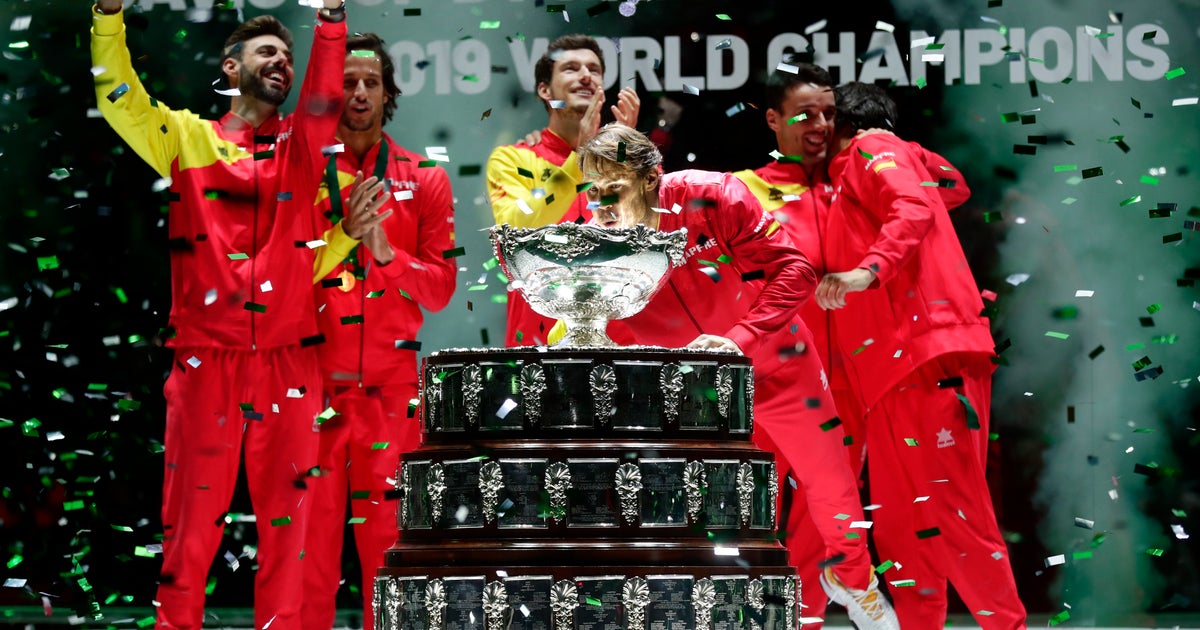New Davis Cup proves exciting but calendar still a challenge


MADRID (AP) — Despite its flaws, the new Davis Cup got a passing grade on its first edition, with its modern look being accompanied by plenty of excitement on the court.
But despite the mostly positive reviews, the future success of the revamped tournament still depends on making it fit on a crowed tennis calendar that already has two other team competitions trying to establish themselves — the Laver Cup and the ATP Cup.
The top-ranked players on tour — Rafael Nadal and Novak Djokovic — don’t think the Davis Cup and the ATP Cup can co-exist. Both suggest a merger would be the best solution.
“I don’t see two World Cups in one month on our calendar. That’s something that I personally don’t see,” said Nadal, who on Sunday led Spain to its sixth Davis Cup title with a win over first-time finalist Canada.
The inaugural ATP Cup, to be played with 24 teams, will take place in January. The Davis Cup debuted in Madrid with 18 teams.
“We have an opportunity to finally have a great competition,” Nadal said. “There is no other way than have only one big, big competition. I think Davis Cup is the right name because it’s part of the history of our sport. And it will be great if we are able to put everything together.”
Djokovic talked about the possibility of a “Super Cup” of tennis.
“Scheduling was always an issue, for both ATP Cup and Davis Cup,” he said. “An idea was the merge between the two. Looking long-term, I personally don’t think that the two events can co-exist six weeks apart. It’s just a little bit too congested.”
The International Tennis Federation signed a 25-year partnership with the Kosmos group co-founded by Barcelona star Gerard Piqué to make the Davis Cup more attractive and lucrative. It transformed the year-long tournament into a one-week event played in a World Cup-style format in a single venue.
“We have to remember, there’s 119-year history that the Davis Cup has and a very important place within tennis and the calendar. The calendar is the challenge. It always has been,” ITF president Davis Haggerty said. “But again, we can only control what we can control, and that is Davis Cup. And we’re doing the best that we can. And again, we’ll sit down with other tennis bodies, but can’t make any promises on what might happen with other events.”
Piqué said the opinion of players like Nadal and Djokovic needs to be heard.
“It makes no sense to have right now two different competitions that are very similar,” he said. “In the next few months I think we will start talking again with the ATP. And I hope in the next few months we can announce something.”
Piqué said talks with Roger Federer, who co-owns the Laver Cup event that is played between European and world teams, have not advanced recently.
“It’s his baby, his competition, and he wants to protect (it). And I totally understand,” Piqué said. “What we will try to do is to try to put the Davis Cup obviously in another level because we are talking about 119 years of history. You cannot compare both events. But we will try to do the best we can for our competition to make it as big as possible.”
Kosmos and the ITF hope to play the new Davis Cup in September instead of making it the season-ending tournament in November. Djokovic said that would make the competition more attractive to players.
“It is the last week of the year. It’s definitely a tough schedule for a lot of players,” Djokovic said. “It’s really difficult because you have a whole season and then you have to push yourself for another week and then eventually play singles, doubles every day.”
EXCITING FORMAT
The Davis Cup new format, with ties being decided in three matches on the same day, created exciting action in Madrid, giving teams small margins for errors.
Previously, the Davis Cup ties were decided over three days in four singles matches and one doubles.
“The format makes things very close,” Nadal said. “You make a mistake in one singles match and in the doubles anything can happen. So things are beautiful that way. But at the same time, for the best teams, it makes things dangerous.”
The change gave extra importance to the doubles matches, which in the old format were played in-between two singles matches.
Five of the seven ties in the knockout rounds of the Davis Cup Finals were decided in the doubles matches.
“For us, it’s cool to get the opportunity to potentially play those deciding matches and, you know, doubles be the discipline that’s deciding whether who goes home with the Davis Cup trophy or not,” British player Jamie Murray said.






